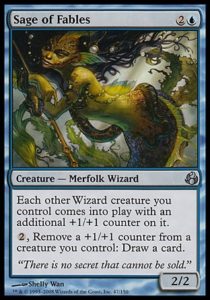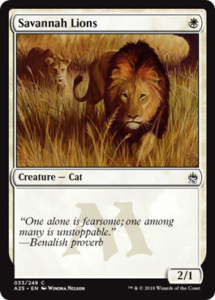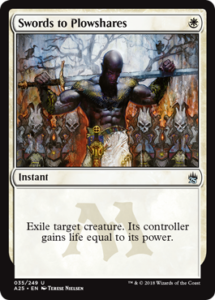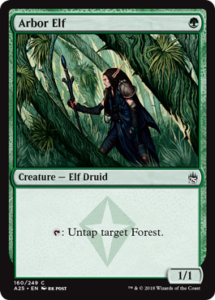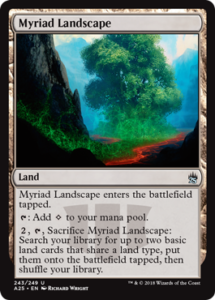Masters 25 releases this Friday in paper and Wednesday on Magic Online. It’s a very different kind of Masters set; it’s not linear, instead focusing on general archetypes, card combinations, and incredibly powerful (and iconic) cards. Gavin Verhey went into a bunch of such combos here, so rather than tell you all the shenanigans you can do with Cloudshift (and there’s a ton, except for flipping Fathom Seer), I’m going to give you a sense of how to play the format.
An intentionally unclear format
Masters 25 reminds me of cubes designed to be different, rife with beloved cards, historically significant combos, and random foils folks had lying around. It’s a format where you’re delving through history and collections, rather than a conventional Limited format with signposts or cube with overt archetypes. Such formats are often defined by disproportionately powerful cards, unconventional synergies discovered while drafting or playing, and committing to a simple archetype: control, aggro, or ramp, with combo being available as an additional option to all (but usually functioning best in control).
Masters 25 also reminds me of chaos draft. In chaos draft, you play with cards designed for completely different contexts, so each card’s power level is drastically different. It’s much harder to take advantage of set mechanics, so you have to defer to drafting basics like B.R.E.A.D. (Bombs, Removal, Evasion, and then Aggro/Defense, or whatever A. and D. meant to your play group—folks were really only serious and consistent about B.R.E.). You have to build your own engines on the fly, so suddenly cards like Sage of Fables become amazing, because every set has some wizards and any value you can eke out can be game-winning.
Now, Masters 25 is an intentionally designed set. Its components might be quite disparate, but all of the pieces are meant to work together. The power level is through the roof, the combos are there for you to find, and the control and aggro elements are quite powerful. The lack of archetypes means that B.R.E.A.D. will be more important than ever, as well as simple archetypes. In other words, you want to figure out if you’re aggro, control, ramp, as well as which combos you’re pursuing.
Aggro
Aggro decks have a simple goal: defeat your opponent before they can resolve expensive spells. There are some incredibly powerful tools available to the aggro-aficionado, from Savannah Lions to Balduvian Horde and Nezumi Cutthroat. White doesn’t have that many impressive aggro creatures beyond Geist of the Moors and black seems best-suited to a supporting role with Vampire Lacerator, Nezumi Cutthroat, and a bunch of removal, but red is designed to beat down. Frenzied Goblin, Jackal Pup, Mogg Flunkies, Crimson Mage, Hordeling Outburst, and Trumpet Blast all tell you exactly what red wants to be doing. Red aggro has all the tools it needs to succeed, as long as it can deal with a 1/3 blocker.
The challenge with this archetype is and always has been running out of steam before your opponent’s cards come online. This archetype is resilient against spot removal like Pacifism but can really suffer against cards like Man-o’-War and Court Hussar which provide value while dealing with a threat, and Death’s-Head Buzzard will completely wreck decks overly reliant on one toughness creatures (which the fastest aggro decks are going to be). The danger in going bigger is that threats like Balduvian Horde and Thresher Lizard both slow down your velocity and are even worse against spot removal.
I expect monored aggro to be potent, if only because it’s doing something both very familiar and being the fun police. I have lower expectations of nonred aggro decks because they have far fewer tools to draw from.
Removal and Control
There is no shortage of ways for control to stall and win the game. Court Hussar, Squadron Hawk, and Dusk Legion Zealot provide value while providing relevant bodies. Horseshoe Crab can win the game almost on the spot with Presence of Gond, Heavy Arbalest, or Quicksilver Dagger. The trick for control is that it both has to be able to survive against the linear aggro decks while not automatically dying to their opponent’s combos.
You need to be able to disrupt a Horseshoe Crab combo at instant speed. You might have to deal with a turn three Krosan Colossus (Arbor Elf or Utopia Sprawl plus Cloudshift). You could have opponents grinding you out with Squadron Hawk plus Brainstorm or five copies of Accumulated Knowledge. You will have to deal with Balduvian Hordes and Frenzied Goblins. In other words, there is a great diversity of threats.
In terms of answers, there is no common catch-all. Man-o’-War is excellent against aggro, midrange, and Cloudshift and Zombify shenanigans, but awful against control and likely too slow for Horseshoe Crab+Quicksilver Dagger combo. Kindle can disrupt small creatures but can’t stop a Horseshoe Crab. Chandra’s Outrage stops crab combo but is terrible against go-wide red and giant creatures. You’re going to need to save cards like Murder and Swords to Plowshares to deal with combos and massive creatures, because Disfigure and Skeletonize have a lot of awkward matchups. Removal like Pacifism is a lot worse than it might appear, since it fails to shut down most combos and fails against heavy aggro. Freed From the Real has similar issues, but it has the advantage of letting you create your own Horseshoe Crabs or even making infinite mana with Arbor Elf plus Utopia Sprawl.
The trick to drafting control is recognizing that you’re assembling different pieces. You need ways to stay alive, card advantage, removal, and ways to win the game. Fortunately, many of these cards pull double duty, such Squadron Hawk, Ravenous Chupacabra, and Court Hussar. Sideboarding well is essential, because sometimes you’ll play the control and need almost no ways to stay alive, whereas other times you’ll be against go-wide red and will win as long as you can survive.
Ramp
This deck’s goal is simple and tends not to fight with other archetypes—it wants to accelerate out enormous threats like Colossal Dreadmaw and Woolly Loxodon as quickly as possible. It is weak to Disfigure and Kindle only in the early game and weak to cards like Path of Peace in the late game. The advantage of ramp is that it provides a stream of must-answer threats for control and is the fastest deck at leaving the early game and mucking up aggro’s game plan.
Ramp seems to be missing cards like Pelakka Wurm—cards that stabilize it against aggro by themselves (no, Stangg does not cut it). It has beefy threats, but absent powerful ETB abilities, getting working hard to ramp out a Colossal Dreadmaw only to see it Pacified or Murdered is horrendous. I’m excited to combine green with other colors to make a multicolor control deck, but I don’t think green has sufficient tools to do the heavy lifting alone. Fortunately, there are plenty of great multicolor cards to ramp into, and cards like Zoetic Cavern means that everyone can ramp, however awkwardly.
Masters 25 looks like a tough nut to crack. To draft well, you really want to have a good read on the table—what archetypes are most open? How do you build your main deck to be advantaged against the most players? There are going to be some tables where everyone wants to draft control—there, the monored drafter is king, but the person who skimped on maindeck methods of staying alive is advantaged against the other six. There will be other tables where no one commits to archetypes, meaning the dedicated multicolor drafter is best able to combine power with consistency.
The format is going to be tough. Committing to a color combination won’t tell you how to prioritize cards. You can’t rest on your laurels and go on rails—drafting is going to be an active process. You’ll have the easiest time going in on Squadron Hawk/Accumulated Knowledge/Relentless Rats/Kindle/Timberpack Wolf.dek, but those cards aren’t as powerful as the other options. This is a raw power format with combos, not a synergy and archetype format. It’s not my cup of tea, necessarily, but I’ll be playing it this weekend and hope it’s a blast.
And, as always, thanks for reading!
—Zachary Barash
Zachary Barash is a New York City-based game designer. He works for Kingdom Death: Monster, has a Game Design MFA from the NYU Game Center, and does freelance game design. When the stars align, he streams Magic.
His favorite card of the month is Heart Warden. It’s a Mind Stone Elf that’s more fair, has more utility, and will hopefully be reprinted sometime soon, perhaps in a Masters set!

